Intro
As soon as the opening of the Estates General was announced, the desire to change the Nation emanated from all walks of life and this moment was apprehended with anxiety or enthusiasm. Already, a strong political impulse ran through the country, Louis XVI and Necker were worried. Who would become the master of the situation? Will the legacy of the Enlightenment speak for the future? How would events unfold? Were we going to irremediably change the course of French life? These questions would soon find their meaning, very quickly the weight of privileges will cause a revolutionary spiral that will only end ten years later.
Major events
The third declares itself “National Assembly”
The Estates General were solemnly opened on May 5, 1789, very quickly a fierce discussion broke out on the way to vote:"per head", one vote for each man, or "by order", a single vote for each of the three states like the wanted tradition. Under the impetus of Mirabeau, the deputies of the Third Estate refused to verify their power in order to avoid voting "by order" at all costs. They hoped to gain time, the various attempts to unblock the situation had proved useless. Conscious of representing the majority of French people, the popular delegates of the third party withdrew on June 17 and constituted themselves the National Assembly. On the same day, the Assembly prohibited any levying of taxes not verified and decreed by itself. Naturally, neither the king nor the privileged class appreciated this novelty. Louis XVI resolves to the rigor and invites the three orders to resume their place at a future royal session.
The palm game oath
On June 20, under the pretext of carrying out maintenance work, the king prohibited access to the room where the States General met. The representatives of the third estate then gathered in a gymnasium which was used for tennis. There, under the proposal of the deputy Mounier, they undertook “never to separate” before having given France a Constitution, each in turn the deputies repeat “I swear it! ". The next day, the king closes the gymnasium, because it is reserved by the count of Artois, the king's brother (Charles X). The deputies then meet in the Saint Louis church that the clergy has granted them. Louis XVI then gathers troops to dissolve this assembly of recalcitrants, but soon a large part of the clergy joins the third party. In order to limit the damage, the king then ordered the clergy and the nobility to participate with the third party in the drafting of constitutional texts. On July 9, 1789, the National Assembly becomes constituent, it will establish the foundations of a constitutional monarchy, we then believe the revolution is complete.
The tennis court oath
In the center, Bailly, the President of the National Assembly is mounted on a table. With him, the deputies swear not to separate until the establishment of a constitution.

The tennis court oath - by Jacques-Louis DAVID (Museum of the Palace of Versailles)
The storming of the Bastille
Very quickly, the assembly began discussions behind the deputy Mounier, and La Fayette who, inspired by his visit to the United States, was already proposing a declaration of human rights. But the king hastened events, he dismissed Necker, his Minister of Finance, who was held responsible for the disorder, it was a real consternation for the people who attached him in esteem. Louis XVI also ordered the concentration of troops around the capital, in order to put down the rebellion with bayonets. Under the leadership of Camille Desmoulins, the Parisian people gathered and anarchy began to settle in the capital. On July 14, the Bastille, an old fortress turned prison which, for Parisians, represented the symbol of absolutism, was stormed and razed. On his return from a hunt, the astonished king asked, “Is it a revolt? "No Sire, it's a revolution." Louis XVI once more backed down and recalled Necker.
Storm of the Bastille
Below, on the right, the governor of the Bastille De Launay is taken away by the assailants. He will be massacred, and his head put on a pike will parade through the streets of Paris.
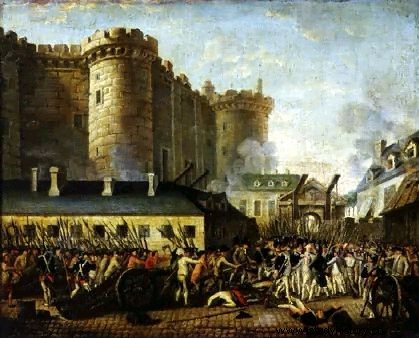
The Storming of the Bastille, July 14, 1789 - by Jean-Baptiste LALLEMAND (Carnavalet Museum)
The “Night of August 4th”
The absolute monarchy was over, and the first nobles began to emigrate. The assembly improvised a National Guard under the orders of the Marquis de La Fayette, and wore the first tricolor cockades (the white of the Bourbons was slipped between the blue and the red of the city of Paris). Very quickly, anarchy sets in in the capital, and alarmist rumors (aristocratic plot, foreign invasion, etc.) provoked "The Great Fear" in the countryside. The fury of the peasants was unleashed against the feudal residences which were burned and ransacked during the summer. On the night of August 4, the Assembly was discussing ways to stop these riots, and as the discussions progressed, it gradually abolished all feudal rights. On August 11, a decree declares civil and fiscal equality, it is the greatest upheaval that France has known. The Old Regime and privileges crumble in the space of one night.
The Declaration of the Rights of Man and of the Citizen
On August 26, the Assembly adopted the Declaration of the Rights of Man and of the Citizen, of which Mirabeau and Sieyès were the main drafters. This statement has now become the model for most modern constitutions. It establishes the fundamental rights of the human being:the right to freedom, to security, to the equality of all before the law and, finally, the principle of popular sovereignty, by which the Nation, and no longer a royalty by divine right, is proclaimed the repository of power. However, this statement does not question the Bourbon monarchy, moreover, La Fayette and Mirabeau as well as the majority of the Assembly are monarchists.
The Declaration of the Rights of Man and of the Citizen

Declaration of the Rights of Man and of the Citizen, dated August 10, 1793 (Historical Center of the National Archives)
Great instability
October days
The discussions between the Assembly and the king resumed, Louis XVI was soon granted a right of veto over the decisions of the assembly. Moderates like Mounier saw their plan to create two Chambers and a strong executive power (as in England) rejected. But instead of agreeing to share his power with the Assembly, Louis XVI thought only of taking back his property, he brought a new garrison to Versailles. On October 5, discontent once again spread to the streets, and around 700,000 women marched on Versailles to beg bread from the king. The king on his return promises a return of wheat to Paris, but the next day, the crowd presses in front of Versailles, and proclaims "To Paris". The king is therefore forced to leave Versailles with his family (“the baker, the baker and the little baker”). Monarchists like Mounier see their desire to establish a strong monarchy die out, Mounier chooses exile.
The constitutional monarchy
Until the summer of 1790, La Fayette was the key man of the moment, his popularity and influence grew every day in the capital, but his greatest rival remained Mirabeau. The Assembly now sits in the Tuileries, since the question of the king's right of veto, it is divided as follows:on the right the supporters of the veto, on the left the opponents. The division of opinions is now organized in this way (these are the ancestors of our political parties). On the extreme right, we find the conservatives attached to the absolute monarchy. On the right, we have the monarchians who want to stick to the reforms of August 4, their leader Mounier has already gone into exile fearing a skid of the Revolution. On the left, the group is led by a triumvirate (Barnave, Lameth, Duport), and on the far left we already find Robespierre. All these deputies meet in clubs, in which the partisans debate the questions of the Assembly, the patriots who met at the convent of the Jacobins adopted this name. In a few months, the Assembly took a series of measures that changed the face of France (confiscation of the property of the clergy, birth of the departments, see Revolutionary France), and in 1791, a first Constitution was ratified.
The Federation
Since 1789, national guards had been formed in the provinces like that of La Fayette, they had to ensure the security of the people and of commerce. Some of these communes had gathered in a federation, the citizens of each of these federations considered themselves as belonging to the same "Empire", and no longer as Angevins or Bretons. These federations gave rise to celebrations, one of which was to bring together each of the representatives of the federations at the Champ-de-Mars on July 14, 1790 to celebrate the feast of the Federation. The guards of each federation filed past, and despite the rain, La Fayette came forward and took the oath to the Nation, then came the turn of the king, who was applauded. It was a real moment of national unity everywhere in France, the party was sumptuous.
Federation Day

The Federation Day - by Charles MONNET 1790 (National Library of France, Department of Prints)
First difficulties
During all this effervescence in Paris, the Army was agitated, in Champagne the future marshal Davout took the head of a revolt. In Nancy, the soldiers mutinied and imprisoned their officers. Bouille, the commander of Metz will organize a repression which will be particularly severe. Necker, worried about the turn of events, resigns on the pretext of a health problem, the Assembly then takes charge of the Public Treasury. On the side of the clergy, it was not much better, the clergymen had to take the oath to the Nation and to the civil constitution of the clergy (see revolutionary France), only few of them did, partly because of the position of Pope Pius VI, who declared the constitution schismatic, and of the king's hesitations. Moreover the financial crisis is not resolved, and discords appear within the Assembly, Mirabeau who was elected president of the assembly dies in March 1791.
The king's flight
From then on, the situation of the king became complicated, he soon asked for recourse to the European monarchies. Marie-Antoinette could count on her brother the Emperor of Austria, but the latter was far too busy disputing Poland with Prussia and Russia. The king's brother, the Comte d'Artois (Charles X) met the European sovereigns at Pillnitz where he won the support of Austria and Prussia. But in Paris, we were suspicious of the king, he had already tried to go discreetly to the castle of St Cloud, only the carriage was quickly stopped and had to turn back towards the Tuileries. The king then thought of joining Bouille's garrison in Metz to return to Paris with the Austrians. And on June 21, 1791, the king's bed is empty, he fled the day before with his family in a sedan, pretending to be a rich bourgeois, he will be joined by Bouille's dragoons. But recognized in Varennes, he was arrested. In Paris, La Fayette, Bailly and Beauharnais (president of the Assembly) invent a pretext of kidnapping to cover their king. But no one is fooled, and the return is difficult for the royal family who must suffer the insults of the people, Louis XVI was therefore suspended by the Constituent Assembly.
Return from Varennes - Arrival of Louis XVI in Paris

Return from Varennes. Arrival of Louis Seize in Paris, June 25, 1791 - by Jean DUPLESSI-BERTAUX (Historical Center of the National Archives)
The Champ-de-Mars shooting
During this time, the Cordeliers club (Marat, Danton) sought the help of the Jacobins (Robespierre, Pétion) to vote for the forfeiture of the king, a split took place among the Jacobins where the most moderate (Sieyès, Barnave, Lameth) founded the Club des Feuillants. But the rest of the Jacobins organized with the Cordeliers a petition voting for the abdication of the king, they had met at the Champ-de-Mars. La Fayette and his guard, who were supposed to ensure order, were greeted by throwing stones. Bailly gave the order to the guard to fire, there was panic, at least 50 dead, Marat managed to hide, Danton emigrated to England. The Cordeliers club was closed and a large part of the Jacobins joined the more moderate Feuillants. The Feuillants, with their new influence in the Assembly now wanted a revision of the Constitution, the Republicans had been removed and the Constitution was voted in September 1791. In October, a Legislative Assembly replaced the Constituent Assembly. The emigrants were granted amnesty, it was believed that the Revolution was over. But economic turmoil, divisions among the clergy, and the king's indeterminacy heralded a bleak future.
The Legislative Assembly
A new wave of newly elected deputies appeared in the Assembly, on the right of which we find the Feuillants, supporters of a constitutional monarchy headed by the Triumvirate (Barnave, Lameth, Duport) and La Fayette, they supported the king. On the left, there are the Jacobins who are less numerous, also called Brissotins from the name of their leader Brissot, their speakers including Vergniaud come from Bordeaux (they will be called Girondins for this reason), they will have to ally with the extreme left represented by Pétion de Villeneuve (close to Robespierre) which brings together members of the Cordeliers (the Mountain). In the center, the Marais which brings together the supporters of a moderate monarchy. Very quickly, the Assembly had to face many problems including a rebellion in the colony of Santo Domingo, the Girondins therefore passed an important decree which placed the Negroes on the same political equality as the whites (abolition of slavery) . Then ultimatums are declared to the emigrants who risk being stripped of their rights. On March 10, 1792, the partly Feuillant ministry resigned in favor of the Girondins.
The European War
Ever since revolutionary ideas developed in the Rhine region or in northern Italy, and since the king's arrest at Varennes, Europe, led by Austria, began to take a dim view of this Turbulent France. The war seems inevitable, only the deputies Marat and Robespierre had opposed the war. But the new ministers partly Girondins want war, this is the case of Dumouriez, the Minister of Foreign Affairs who precipitate events. On April 20, 1792, war was declared on Austria, soon France would oppose all of Old Europe for nearly 20 years. It was during these campaigns that the war song for the Army of the Rhine began to spread, soon to be called the Marseillaise:composed in Strasbourg by an officer, Rouget de Lisle, it was sung for the first time by a group from Marseille to Paris. Very quickly, an offensive led by Rochambeau quickly turns to disaster, and soon it is the French rout.
Rouget de Lisle composing the Marseillaise
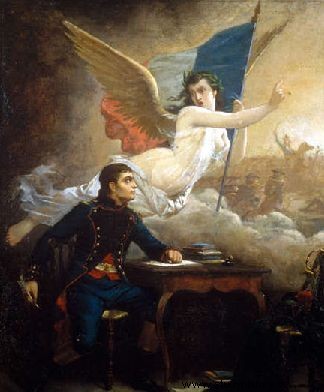
Rouget de Lisle composing the Marseillaise - by Auguste Pinelli 1875-1880 (Historical Museum of the French Revolution, Vizille)
The overthrow of the monarchy
The fall of the monarchy
On June 20, 1792 (anniversary of the tennis oath), the Parisian people armed themselves with pikes and quickly invaded the Tuileries. The demonstration was stopped during the afternoon thanks to the intervention of Vergniaud and Pétion de Villeneuve ( mayor of Paris). La Fayette returned from the armies of the East defends the king and denounces the machinations of the clubs, but discouraged he will leave for the border. Brissot and the Gironde will try to ally themselves with the king, but they cannot prevent the request for a decree ordering his forfeiture. On August 10 an insurrection had been prepared, the insurgents had armed themselves, Danton, who was organizing the rebellion, had taken possession of the Hôtel de Ville. We were now heading for the Tuileries. Faced with the incompetence of his guard, without a leader, the barely awake king tries to take refuge in the Assembly. At the Tuileries, the Swiss Guards fire on the insurgents. But a fury inhabits the rioters who massacre gentlemen (Clermont-Tonnerre). During this time in the Assembly they had voted to suspend the king and his internment in the prison of the Temple. Huguenin the president of the insurrectionary commune (which drove out the Commune of Paris, sort of municipal government) asks for the dissolution of the Assembly and prepares an alliance with the Gironde left. This will now play a leading role, Danton takes the head of an executive council, only Montagnard he dominates the ministry largely Girondin.
Taking of the Tuileries
On August 10, the sans-culottes stormed the Château des Tuileries, the Swiss Guards fired on the crowd. The king, meanwhile, took refuge with the deputies.

The Taking of the Tuileries Palace, Cour du Carrousel, August 10, 1792 - by Jean DUPLESSI-BERTAUX 1793 (Fabre Museum)
The birth of the republic
Very quickly, Danton, the man of the moment, reorganized the country and signed numerous treaties which were to organize resistance to the Prussian enemy who was already in France. Dumouriez replaced La Fayette (who had gone over to the enemy with the Austrians) in the army of the north, which was reorganized, and the soldiers of the former royal army joined the patriotic volunteers. The generals were going to make this amalgam into a real army, battalion commanders were going to climb the steps that would bring them to the title of marshal under Napoleon (Bessières, Marmont, Davout, Victor...). But they cannot block the road to Paris to the Austro-Prussians, Kellermann and Dumouriez are now the last ramparts. Meanwhile, in Paris, refractory aristocrats and priests were suspected of massacring patriots, in this climate of suspicion from September 2 to 6, massacres took place, Parisian rioters emptied prisons crowded with supporters of the king, there were about 1,200 you are. In the commune and in the Assembly they had allowed things to happen while pretending to ignore the facts, but this popular enthusiasm discouraged the moderates, and the idea of a Republic took off under the influence of the Montagnards. Indeed, the new elections of the Assembly, which took the name of Convention (on the American model) saw the rise of the Montagnards (Fabre d'Églantine, Desmoulins, David, Philippe Égalité the Duke of Orléans...) . The most popular deputies at this time were Danton, Marat and Robespierre. On September 20, the incredible happened, Kellermann and Dumouriez managed to repel the Austro-Prussians at Valmy, where a real national feeling was felt. The next day (September 21, 1792) the Convention held its first public session, it was the birth of the First Republic.
The National Guard of Paris leaves for the army - September 1792
On July 11, 1792, in the face of military defeats and threats of invasion (of the Prussians of the Duke of Brunswick and of the emigrants of the Prince of Condé), the legislative assembly declared "the Fatherland in danger" and the raising of 50,000 volunteers among the national guards. At the end of the summer, the military situation becomes dramatic. Longwy capitulates on August 23 before the Prussians, Verdun surrenders. On August 26, the assembly then approved, on Danton's proposal, a new levy of 30,000 men.
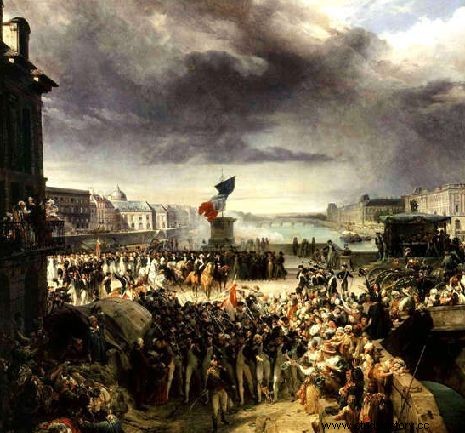
The National Guard of Paris leaves for the army. September 1792 - by Léon COGNIET 1836 (Fabre Museum)
The Agreement
The first president of the Convention was Pétion (already mayor of Paris). The Girondins were this time dominant in the assembly, but there was no one to represent the sans-culottes (Parisian people) who had made August 10th. The Girondins (Roland, Vergniaud, Brissot...) who meet in Mme Roland's salon are close to the Mountain (Robespierre, Marat, Danton, Desmoulins, St-Just, Philippe Égalité, David...) from the point of view social and patriotic but these are closer to the sans-culottes and the Paris Commune. Between the two groups there is always the marsh or the plain, a group of undecided people twirling to the left or to the right. The monarchists have therefore disappeared, and it is the Girondins who take their place on the right. The real conflict is therefore between the Girondins, older and attached to private property, and the Montagnards, more revolutionary and defenders of the common people. Clashes and denunciations run through the Assembly every day, but the Montagnards thwart the traps of the right and promote the erosion of the Girondins. Abroad, the victory of Valmy preceded the annexation of the county of Nice and Savoy.
The King's Trial
One of the missions that the Convention had set itself was to settle the fate of the monarchy, in the Gironde we were divided, but in the Mountain, we wanted the death of the king. The sacking of the Tuileries on August 10 led to the discovery of a secret cabinet containing documents in which were mixed the reports of Louis XVI and the European powers. A legal procedure therefore began, the deputies almost unanimously declared Louis Capet guilty of conspiracy against the general security of the State. Each of the representatives of the departments was now going to express the proposed punishment, it was death that won. And on January 21, 1793, Louis XVI was guillotined, this irreversible act caused the indignation of all of Europe. France found itself even more isolated. England, under the impetus of its Prime Minister William Pitt, gathered against it a coalition (the first of a long series) which included, in addition to Austria and Prussia, Spain, Holland, Portugal and Russia.
The King's Execution
After the fall of the monarchy, Louis XVI bore the name Louis Capet, in reference to Hugues Capet, founder of the Capetian dynasty (in 987) from which the Bourbons originated. On January 21, 1793, Louis XVI climbed the scaffold, his last words were:“I die innocent! », his head is shown to the crowd shouting:« Long live the Nation! .

Execution of King Louis XVI
The Rise of the Terror
General reorganization
Dumouriez, who still commanded the army, had already expressed his opposition to the Convention. He was looking for a victory to cover himself with glory, he only found a new defeat at Neerwinden, desperate, he turned his army against Paris and passed under Austrian orders, some generals including the Duke of Chartres (Louis-Philippe I), son of Philippe Égalité will follow him by his side. The army is now reorganized into blues (republican volunteers) and whites (former royal army). During this time, a conference of the allies takes place in Antwerp, it sets itself the goal of reducing France to political nothingness. But the 280,000 foreigners who are on the borders of France are paralyzed because of dissension between allies. In Paris, a defense committee was created to replace the executive power lost in 1792. It was the Montagnards around Danton who would gain influence and popularity over the Girondins.
The Vendée insurrection
For some time the province had been struggling to follow the course of events, the countryside was still attached to the king and to religion. Also, the civil constitution of the clergy and the execution of the king had deeply shocked. The raising of 300,000 men for the war against Europe was the spark in the powder. At Cholet, the first disturbances broke out, the authorities were attacked with pitchforks or scythes. At the same time, a group of insurgents:the chouans (under the leadership of the Cottereau brothers) also practice guerrilla warfare in the groves and forests. But the Vendeans quickly improvise leaders (the commoner Cathelineau and the nobles Bonchamp, Charette, La Rochejacquelein or D'Elbée), they approach the white cockade and jostle the Republicans, together they form "the great Catholic army". A Republican army was tasked with putting down the revolts, but in 1793 D'Elbée or Bonchamp won valuable victories, giving them control of the region. The successes of the Vendeans will soon be offset by the terror that the region will experience, Republicans will organize bloody repressions (the drownings of Carrier, the infernal columns of Turreau burning the land). In Lyon or in the South, they also ceased to obey the Convention, civil war was declared.
The Vendée War (1793 - 1801)
The Vendée insurgents form three armies organized on three poles. The army of the Marais around Legé, the army of Anjou around Cholet and the army of the center in the bocage. The Angevin regions are made up of high hedges conducive to ambushes. Hidden, the Vendeans rush on their enemies at the given signal, and surround them, if the enemy retaliates, everyone goes to hide in the hedges. Hoche then Bonaparte worked to pacify the region. The unrest only subsided after the signing of the Concordat of 1801.
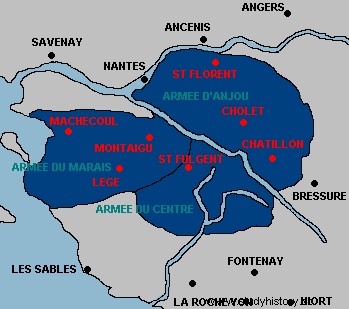
The fall of the Girondins and the federalist revolt
Since the creation of the Convention, a permanent confrontation takes place in the assembly, the Girondins oppose the Montagnards, the latter can rely on the support of the sans-culottes and the insurrectionary commune behind Hébert. A host of fanciful accusations ran through both camps. But the Girondins who are still in the majority in the Convention can enforce their decrees. In the town, we do not stop there, on June 1 Marat sounds the tocsin calling for an insurrection, the battalions of Hanriot have guns facing the Tuileries. The prisoner deputies are forced to sign a decree which imprisons some of the members of the Gironde (Vergniaud, Brissot, Pétion...). Thus with the help of the Commune, the Mountain put an end to the power of the Girondins. In the provinces, however, they had risen up against the Montagnarde Convention. In Lyons, Marseilles or in Normandy, Girondine armies were raised, while Toulon and Bordeaux fell into the hands of the royalists. On July 13, Marat was assassinated in his bathtub by Charlotte Corday, the federalist revolt then gained importance, but the opponents of the Montagnards:royalists and Girondins could not agree. Meanwhile in Vendée, Cathelineau leads deadly skirmishes and extends his influence beyond the Loire. And the external borders are attacked from all sides by the European coalition, English, Spaniards, Prussians and Austrians win decisive victories contesting the revolutionary conquests after Valmy. Threatened from within and without, the Convention seems to have an ephemeral future.
Marat murdered
Coming from a pious and royalist background, Charlotte Corday was a Republican and frequented the Girondins de Caen. She had seen in Marat the main person responsible for the fall of the Girondins.
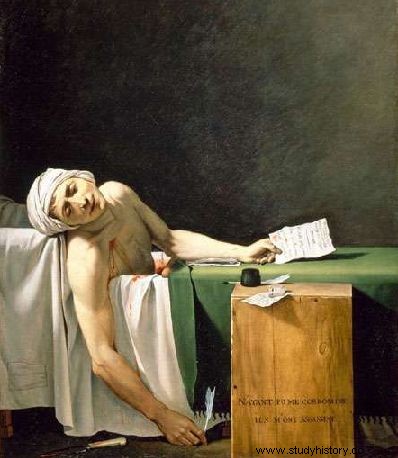
Marat assassinated, July 13, 1793 - by Jacques-Louis DAVID (Fabre Museum)
The revolutionary government
The drafting of the constitution, which began in September 1792, was completed in June 1793 by Saint-Just and Hérault de Séchelles. But in the face of the internal and external situation, the constitution is set aside in favor of a revolutionary government which would reign until peace, only peace will never arrive and this constitution will never have served. The effective government was entrusted to a Committee of Public Safety within which Robespierre acted as dictator. The internal situation is taken in hand, the federalist hearths are repressed especially in Lyon where Fouché or Collot d'Herbois carry out a bloody repression organizing massacres, 6.000 people will perish in one day. In Caen and Marseilles, the Republicans regain the advantage over the Federalists. There remained Toulon where the royalists with the complicity of the English fiercely guarded the city, it was necessary to wait for the arrival of Bonaparte to change the situation. En Vendée, Cathelineau est mortellement blessé à Nantes, il est remplacé par D'Elbée. Les républicains pratiquent alors la tactique de la terre brûlée, mais Marceau et Kléber sont repoussés par Charette et D'Elbée qui bénéficient de l'aide britannique. Bientôt, des Bretons et des Normands se joignent aux Vendéens, mais Kléber et Marceau réorganisent l'armée des bleus et déroutent les blancs de façon décisive. Femmes et enfants sont alors massacrés et la Vendée devient un cimetière national. Aux frontières, le territoire national fut libéré, grâce à de jeunes généraux enthousiastes et audacieux (Hoche, Marceau, Kléber, Jourdan ou Moreau) bousculent les traditions militaires de la vieille Europe et se couvrent de gloire. Carnot le ministre de la guerre favorisa aussi les victoires en organisant l'armée révolutionnaire :en pratiquant le mélange des soldats de métier et des jeunes recrues :« l'amalgame », il alliait l'expérience et la ferveur révolutionnaire. Aux Pyrénées (Kellermann), au Rhin (Hoche, Pichegru) et au Nord (Houchard) l'ennemi est sévèrement repoussé.
La Terreur en action
A Paris, la Terreur derrière Robespierre était décrétée, et le calendrier révolutionnaire est adopté. Un tribunal révolutionnaire condamna des milliers de suspects. La guillotine récemment inventée va alors être utilisé en cascade. Fouquier-Tinville qui dirige le tribunal révolutionnaire va fournir les accusés. Dès juin 1793, la machine est en marche. Avec humilité, Marie-Antoinette ouvre le bal lors de son exécution (15 octobre 1793). Vingt-et-un Girondins seront également condamnés, il en restera que vingt survivants. Puis Philippe Égalité, Manon Roland, Bailly, Barnave, Houchard prendront le relais. La crise économique persistante favorisa l'essor des « Enragés », qui préconisaient des mesures plus sévères pour la bourgeoisie. Inquiété, la Convention et même la Commune jugèrent leur chef Jacques Roux, qui préférant le suicide mit fin à ce mouvement populaire. Les « Hébertistes » qui sous la conduite de Hébert regroupaient une grande partie de la Commune, du club des Cordeliers et des sans-culottes. Ils étaient néanmoins plus présents que les Enragés, ils s'attaquèrent à la Convention par le biais du journal d'Hébert (Le père Duchesne). Ils enchaînèrent la déchristianisation du pays, en saccageant les églises et en organisant des mascarades anticléricales dans Paris. Hébert qui gagnait de l'influence fut arrêté, jugé puis guillotiné avec ses partisans. Enfin, un troisième mouvement connut le couperet de la guillotine :« Les Indulgents », ils rassemblaient des personnalités lassés de la Terreur, qui préféraient la fin des exécutions, sous l'impulsion du journal de Camille Desmoulins (Le vieux cordelier) et de Danton qui lui apportait de plus en plus son soutien. Mais jugé pour corruption Fabre d'Églantine annonça l'élimination des dantonistes, et quelques jours plus tard, Danton et Desmoulins étaient sur l'échafaud.
Marie-Antoinette conduite à son exécution le 16 octobre 1793
Avec un grand courage, Marie-Antoinette se soumet à la loi du couperet. La guillotine est un symbole indissociable de la Terreur. Quelques temps plus tard, c'est Danton qui monte sur l'échafaud en déclarant au bourreau :« Tu montreras ma tête au peuple, elle en vaut bien la peine. »
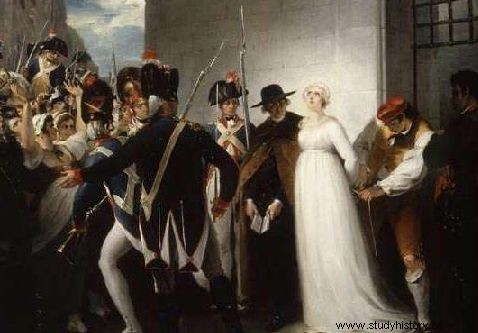
Marie-Antoinette conduite à son exécution le 16 octobre 1793 - par William HAMILTON 1794 (Musée historique de la Révolution française, Vizille)
La fin de la Terreur
La conspiration du 9 Thermidor
Robespierre entama des mesures qui changèrent la France (voir La France révolutionnaire), et malgré des revers sur les mers, les victoires continentales (Fleurus) se succédaient. Mais en éliminant les factions (enragés, Hébertistes et Indulgents), le Comité de salut public perdit l'appui des sans-culottes et prépara ainsi sa chute. Robespierre qui avait instauré le culte de l'Être suprême était accusé d'accéder de plus en plus vers la dictature. « L'incorruptible » fréquentait de plus en plus le club des Jacobins où il excluait ses ennemis. Ces derniers se rassemblèrent (Collot d'Herbois, Fouché, Barras, Tallien) et réquisitionnèrent l'appui du Marais (Cambacérès, Boissy d'Anglas). Et le 8 thermidor, ces opposants s'emploient à accuser les robespierristes. La nuit, on se réunit et on prépara la séance du lendemain. Là, les robespierristes sont immobilisés et cinq d'entre eux sont arrêtés. Mais ils sont délivrés par la Commune un peu plus tard, l'Assemblée mit alors hors-la-loi les cinq députés ainsi que la Commune. Mais les gendarmes que dirigeait Barras firent irruption dans l'Hôtel de Ville où s'étaient réfugiés les proscrits. Ceux-ci sont malmenés (Robespierre reçoit un coup de feu à la mâchoire, Le Bas s'explose la cervelle). Arrêté, Robespierre fut guillotiné le lendemain avec vingt de ses partisans les plus fidèles, dont l'implacable Saint-Just. La mort de Robespierre mit fin à la Terreur en 1794, ainsi qu'à la phase la plus ardente et la plus populaire de la Révolution. Les modérés, représentant surtout la bourgeoisie d'affaires, eurent de nouveau le dessus.
La réaction Thermidorienne
Ces bourgeois modérés (Tallien, Barras, Fréron) avec le centre, qui est resté silencieux depuis le début de la Révolution forment « la jeunesse dorée », derrière leur tenue excentrique, ils affichent leur nostalgie de la monarchie. Ensemble, ils reprirent le pouvoir avec fermeté et entreprirent un remaniement politique, Fouquier-Tinville qui dirigeait le Tribunal révolutionnaire fut emprisonné. La Montagne entachée par la Terreur n'acceptait pas ce revirement de situation, mais bientôt les jacobins sont attaqués, et la Gironde est réintégrée à l'Assemblée. Des troubles populaires survinrent, Billaud-Varenne, Collot d'Herbois et Barère qui étaient emprisonnés pour leur rôle dans la Terreur furent défendus par les sans-culottes. En prairial, une nouvelle insurrection a lieu sous influence montagnarde, le député Féraud est tué. Mais ces troubles n'engagèrent que peu de monde, la garde nationale s'était réorganisée, les sans-culottes avaient perdu. Mais dans le Midi, la « Terreur blanche », sous impulsion royaliste, est particulièrement sanglante et fait plusieurs victimes :des jacobins puis des républicains à Lyon. En Vendée, la région est pacifiée grâce au général Hoche, et la convention multiplie les amnisties. Mais les chouans puis Charette reprenne très vite les hostilités, des royalistes débarquent à Quiberon en Bretagne, ils sont arrêtés par Hoche. A l'extérieur, les jeunes généraux font toujours des merveilles, et la Guadeloupe et Saint-Domingue sont reprises. Louis XVII meurt au temple, son oncle, le comte de Provence devient Louis XVIII.
Émeutes de prairial
Le député Féraud qui tentait de s'opposer aux manifestants est tué, sa tête est mise au bout d'un pique. Puis elle est présentée au président de l'Assemblée :Boissy d'Anglas, qui la salua, il résista avec sang-froid et gagna du temps. L'émeute sera ensuite canalisée par l'arrivée de la garde nationale, les sans-culottes ont perdu leur pouvoir d'action dont ils avaient fait preuve le 10 août.
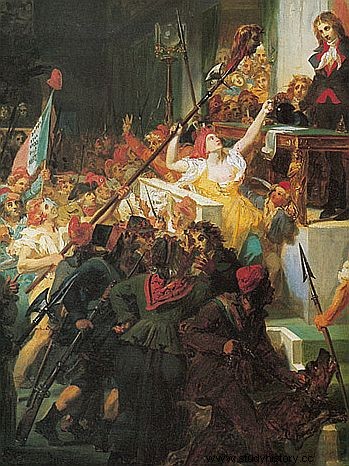
L'assassinat de Féraud à la Convention - par Jean DUPLESSI-BERTAUX
Le Directoire
L'avènement du Directoire
Une troisième constitution, dite « de l'An III », fut rédigée, elle s'appuyait sur un pouvoir exécutif constitués de cinq membres (directeurs), en place pour cinq ans et de deux chambres législatives renouvelable (Conseil des Cinq-Cents et Conseil des Anciens). Pour éviter d'être balayés par les prochaines élections, les derniers conventionnels (membre de la Convention) établirent un décret qui obligea les chambres parlementaires à contenir au moins deux tiers des membres de la Convention, les députés sont ainsi perpétrés. Les royalistes, ulcérés par ce décret qui les paralysaient, tentèrent un nouveau coup de force. Un comité d'insurrection s'était formé, et la Convention qui siégeait toujours aux Tuileries était menacée. Le général Bonaparte était chargé de la répression, à ses cotés Brune et Murat. Il chargea d'abord Murat de lui ramener des pièces d'artillerie, puis il les soumit intelligemment dans la ville. Les royalistes subirent une canonnade sévère, et la Convention fut sauvée par ce général fougueux qui faisait ses premiers pas. Les élections virent triompher des modérés issus des Feuillants et des conventionnels de la droite tel que Boissy d'Anglas. Cette nouvelle ère est appelée le Directoire, on distingue trois périodes séparés par deux coups d'État (18 fructidor, 30 prairial).
Le premier Directoire
Le Directoire n'est pas vraiment en rupture avec la convention thermidorienne, les mêmes hommes sont au pouvoir. Le Directoire joue un rôle charnière qui visera à mettre fin à la Révolution en tentant de réconcilier les royalistes à droite (qui se sont renforcés lors des élections) et les patriotes jacobins à gauche. Les cinq premiers directeurs élus sont La Revellière-Lépeaux, Letourneur, Reubell, Sieyès (qui refuse le poste pour Carnot) et Barras. Le problème principal des directeurs est de faire face à la crise économique qui n'a pas vraiment connu d'essor depuis 1789. Mais dans les rues de Paris, un nouveau comité insurrectionnel (Conjuration des Egaux) est créé sous la conduite de Gracchus Babeuf qui prône « la communauté des biens et des travaux ». Ce comité s'apprête à soulever les masses populaires contre le Directoire, responsable de la famine ouvrière. Trahis par la police nommée par Carnot, les conjurés sont arrêtés, Babeuf est exécuté.
Le deuxième Directoire
A droite, les monarchistes étaient en plein essor, ils sollicitèrent l'aide du général Pichegru qui était favorable au mouvement. Une forte action politique était engagée pour basculer le tournant des élections de 1797. Ces élections affaiblirent fortement le Directoire, et Pichegru fut élu président du Conseil des Cinq-Cents. Les réformes révolutionnaires se trouvèrent alors clairement menacées. Les directeurs se sentent rapidement en danger, et Barras invite Hoche à lui venir en aide. Le projet tombe à l'eau mais l'armée vacille tout de même du coté des directeurs. Les Conseils royalistes comptaient sur Pichegru, tandis que les directeurs s'appuyaient sur Augereau que Bonaparte a envoyé d'Italie pour « sauver la République ». Celui-ci met en avant les preuves que Bonaparte a trouvées en Italie montrant la trahison de Pichegru avec l'étranger. La minorité républicaine de l'Assemblée vota des lois d'exception contre les monarchistes, beaucoup furent contraint à l'exil comme Pichegru et Carnot. Ce coup d'état du 18 Fructidor (An V du calendrier révolutionnaire) redonnait le pouvoir aux républicains qui en profitaient pour annuler les élections qui voient triompher les jacobins (22 floréal), ces derniers ont fait leur retour grâce à l'affaiblissement de la droite lors de fructidor. En Italie, Bonaparte réalise des prouesses inespérées et alarme l'Europe par la création de républiques sœurs vassales de la France.
Coup d'état du 18 fructidor an V
Avec l'aide de Augereau, le Directoire fait arrêter les députés royalistes qui leurs disputaient le pouvoir.

Coup d'état du 18 fructidor gravure fin XVIII s (Bibliothèque nationale Paris)
Le troisième Directoire
Bonaparte est l'homme du moment, il est acclamé à Paris à son retour d'Italie. Le Directoire l'éloigne en lui offrant un commandement en Égypte. Mais aux frontières, les premiers revers apparaissent, Jourdan et Bernadotte quittent leur commandement à l'armée du Rhin. L'Angleterre commence déjà à rassembler une seconde coalition. L'absence de Bonaparte en Italie se fait sentir et les premières défaites apparaissent. Pour remédier à ces échecs militaires, le Directoire rend le service militaire obligatoire et universel. En juin 1799, les Jacobins sont toujours à la tête des élections. Les nouveaux députés forcent alors trois directeurs à la démission (coup d'état du 30 prairial). Sieyès et Barras qui sont à la tête du pouvoir exécutif craignent alors un retour du jacobinisme, les survivants de la Montagne sont en effet présents, et le club des Jacobins se reconstitue. Sieyès profite du retour de Bonaparte pour mettre fin au Directoire, ce dernier allait s'emparer du pouvoir lors du coup d'état du 18-19 brumaire. Mais, au moment où ce général instaura son pouvoir, dix années après le déclenchement de la Révolution, le visage de la France avait bien changé.
